Classic universal grape variety "Delight"
Breeders are constantly working on grapes, crossing varieties and hybrids with each other. Thanks to this, plants with large sweet and aromatic fruits were obtained from wild wild berries with small tart berries. Some are especially delicious fresh as a stand-alone dessert, while others are best for making wines and drinks.
There are also universal varieties. Delight is one of them. It is highly resistant to negative environmental factors and large, fragrant fruits. What else is attractive Delight and what varieties were bred on its basis, you will learn from the article.
The content of the article
General description of the grape variety Delight
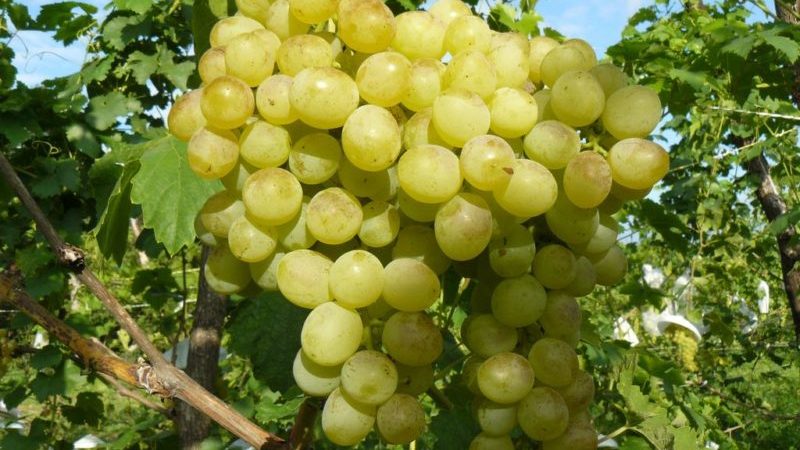
Delight is an old strain. It was bred by crossing the Russian Early, Zarya Severa, Dolores at once. It was included in the State Register in 1922.
Delight is suitable for growing in most regions of our country, including Siberia and the Urals. It is also popular in Belarus, the Baltics, and Ukraine.
Description of grape variety Delight:
- Bush. Medium vigorous. Good ripening of shoots, of which up to 85% are fruitful. On a well-formed grape bush, up to 45 eyes are formed. The trunk and branches are powerful and durable. They bend, but do not break under the weight of the berries.
- Leaves. The leaf plates are large, light green, with jagged edges.
- Berries. Medium size, rounded oval. The size of each reaches 27x24 cm, and the weight is 6-7 g. Fruits are white or cream-colored on the shady side and yellow-orange on the sunny side. The skin is firm but not hard. The pulp is crispy, juicy, non-watery, without mucus. The taste is sweet with a slight sourness, rich aroma. The acidity is 5-9 g per liter. The berries contain up to 26% of the total weight of sugars. There are a small number of seeds.
- Bunches. The shape is usually conical, but clusters of irregular shapes are found. They are large, on average, their weight ranges from 0.5-1 kg. The weight of the largest of them reaches 2 kg.
- Immunity. High resistance to gray mold, powdery mildew, mildew and other diseases. No immunity to phylloxera.
- Productivity. High. An average of 8 kg of crop is harvested from one bush.
- Ripening terms. Early. They are 105-120 days. Ripe berries hang on the bush and do not fall for up to 2 months.
- Drought resistance. Average.
- Frost resistance. High. The plant tolerates frosts down to –25 ° C.
- Bloom. Abundant. Negative environmental factors, except frost, do not affect this indicator. The flowers are bisexual. With insufficient pollination, the berries become small.
- Transportability. High. Berries do not crack or wrinkle when transported over long distances.
Gardeners have noticed that Rapture almost never eats wasps. This is due to the fact that the berries do not crack and the sweet pulp is hidden under the dense skin.
Grape-based varieties Delight
Many new varieties have been developed on the basis of Delight grapes. Consider those of them that have retained the name of their ancestor in the name.
All of them are highly frost-resistant and are suitable for growing in central Russia. According to gardeners, the conditions of Siberia, the Urals and the Far East are suitable for the plants.
Note! The colder climates Rapture grows, the later its fruits ripen.
Delight perfect grapes
It differs from its progenitor in later maturation, which takes up to 130 days. The berries are white, larger (up to 10 g) and juicy. Frost resistance is also increased, since the hybrid can withstand cold snaps down to –30 ° C without shelter. In warm regions, the berries are ready for harvest in mid-June, and in cold regions - in mid-August. Has increased resistance to cracking and rotting of fruits.
Nutmeg delight
An early hybrid of white grapes with a ripening period of 100-110 days. The berries are oval, smaller than those of Rapture. The average weight of each of them is 4.5 g. The fruits taste sweeter, as they contain about 28% of sugars. Withstands frosts down to -30 ° C. The fruits are harvested immediately after ripening, since they are not stored on the bush. When assembled, they do not deteriorate for several months. The bunches are conical or cylindrical. The maximum weight of each of them is 750 g.
Delight is oval
The ripening period is 110-120 days. Differs in large white oval fruits. Each berry weighs 10 g. The pulp is sweet and juicy. The bunches are conical in shape. The weight of each of them on average reaches 0.8-1 kg. The variety tolerates frosts down to –25 ° C. Differs in increased productivity.
Delight is black
A relatively young tall hybrid. It is distinguished by the bluish-black color of berries, the weight of each of which reaches 12 g. The skin of the fruit is thin, the pulp is less sweet than that of Rapture, since the concentration of sugars reaches only 20-21%. The bunches are cylindrical. Each of them weighs 1 kg. The largest bunches weigh 2 kg. Has a high yield.
Red delight grapes
Produces pink fruits. The berries are cone-shaped, slightly sour, sugar content - 20%. The weight of each fruit varies between 7-10 g. The bunches are conical or shapeless. On average, they weigh 700-900 g, but can reach 1.5 kg. Withstands cold snaps down to –25 ° C. It is immune to all diseases inherent in the culture.
Advantages and disadvantages
Delight is one of the most popular grape varieties. This is due to its advantages:
- high frost resistance;
- large sweet fruits;
- high yield;
- immunity to most diseases inherent in the culture;
- drought resistance;
- early ripening;
- good keeping quality;
- resistance to cracking and rotting of berries with a long stay on the bush;
- high transportability.
The variety also has disadvantages. This is the need to form a bush, exactingness to the composition of the soil, lack of immunity to phylloxera.
Is wine made from this grape variety
Delight is the perfect variety for homemade wine. The berries have enough acids and sugars and almost no mucus.
It is important to pick fully ripe berries, but do not let them hang ripe on the bush. Overripe, cracked and rotten fruits will not work. Therefore, it is important to carefully sort the bunches.
Advice! If the grape fruits are cleaned of twigs, then the wine will turn out to be softer, and if left, then tart.
Reproduction
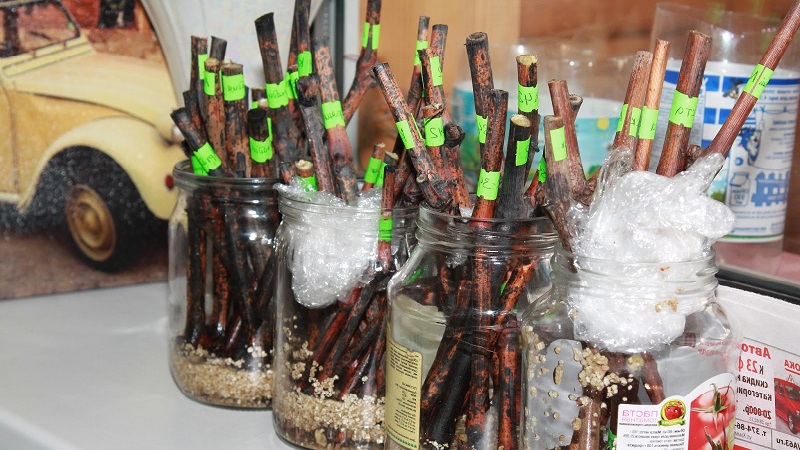
Delight is propagated only in a vegetative way, since when using seeds, the resulting plants do not retain varietal characteristics.
There are 3 methods of vegetative cultivation of grapes:
- Cuttings. The most common way. The planting material takes root well, but you need to harvest 2 times more branches than the desired number of seedlings.
- Graft. This method of grape propagation involves grafting Rapture cuttings onto wild stock or other varieties. Thus, it is possible to obtain a hardy plant that is resistant to all diseases of grapes. Grafting is considered the most reliable way to grow delight.
- Root processes. This is a less common method for propagating grapes.To get planting material, you will have to wait a long time and there are not many seedlings. However, the root shoots take root well.
For grafting and grafting at an angle, twigs 10-12 cm long are cut from a healthy mother plant that has already borne fruit. They should have at least 2-3 eyes. Cuttings are treated with heteroauxin and a solution of potassium permanganate, stored until planting in a cool place or refrigerator.
Planting seedlings
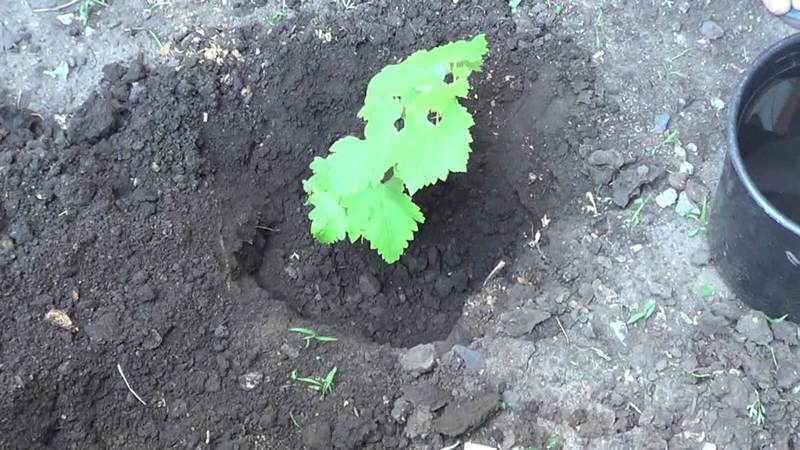
In nurseries and on the market, ready-made Rapture seedlings can be purchased. Choose 1-2 year old planting material. The seedlings should have several branches, healthy living buds, and the root system should be well developed, without rotten and dry roots.
Seedlings are planted in a permanent place in the spring, when the soil warms up or in the fall after leaf fall. Autumn planting is preferable, since in this case the plant will quickly take root from winter to spring. When planting in spring, grapes will need constant care.
For planting choose areas with maximum sun exposure. Groundwater should run no closer than 1.5 m to the surface.
The site is prepared one month before planting. It is weeded, dug up and watered with a solution of copper sulfate.
How to plant Delight grape seedlings:
- Dig holes with a diameter of 60 cm and a depth of 40 cm.
- Drainage is poured at the bottom (shell rock, crushed stone, expanded clay).
- The soil removed from the recess is mixed with 6 kg of rotted manure, 1 kg of ash, 20 g of potassium sulfate and 30 g of superphosphate, with a bag of sand.
- An earthen mound is formed at the bottom of the hole.
- The roots of the seedling are soaked for 6 hours in Kornevin's solution. If the root system is closed, then this is not necessary.
- The seedling is placed in the center of the hole. The roots are evenly distributed around the mound.
- The soil around the seedling is compacted. Then the grapes are watered with 1-2 buckets of water.
- The trunk circle is covered with mulch. Use hay, straw, peat, or humus.
Subtleties of further care
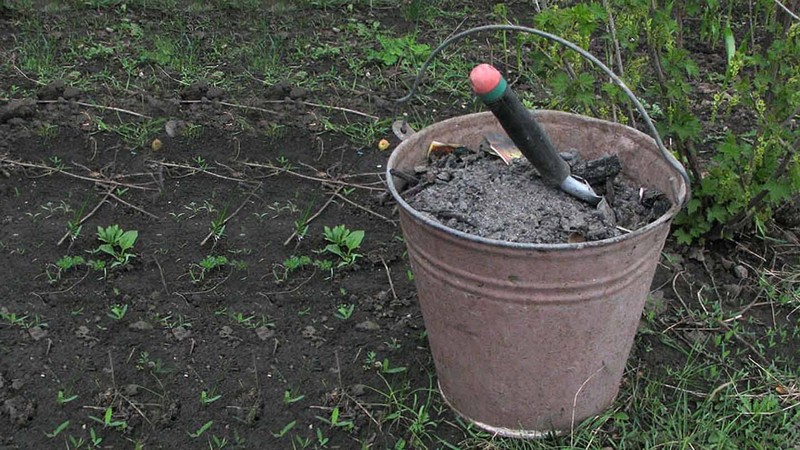
In order for the grapes to fully develop, it is important to properly care for them. The list contains basic rules:
- Watering. Despite the fact that Rapture is drought tolerant, it needs watering. In the hot dry summer, the grapes are watered 2 times every 7 days. If the summer is rainy, then the amount of watering is reduced. Use settled water at room temperature. 1 liter of water is poured under one plant.
- Top dressing. Fertilizers are applied once a month. Phosphorus-potassium fertilizing and manure diluted with water in a ratio of 1:10 alternate. Fertilizers are applied the next day after watering.
- Topping. In spring, the shoots are pinched, leaving 4-10 eyes on them. Remove excess leaves that obscure the bunches. The fewer the eyes, the larger the berries will be.
- Pruning... It is recommended to form a plant in spring. The grapes are given a crown or spherical shape. In the fall, they carry out sanitary pruning, removing old, damaged and diseased branches.
- Preparing for winter. In the fall, all leaves and plant debris are removed from the site. The vine is bent to the ground and fixed with a bracket. Harbor grapes only if the winter turned out to be frosty, but snowless.
Disease and pest control
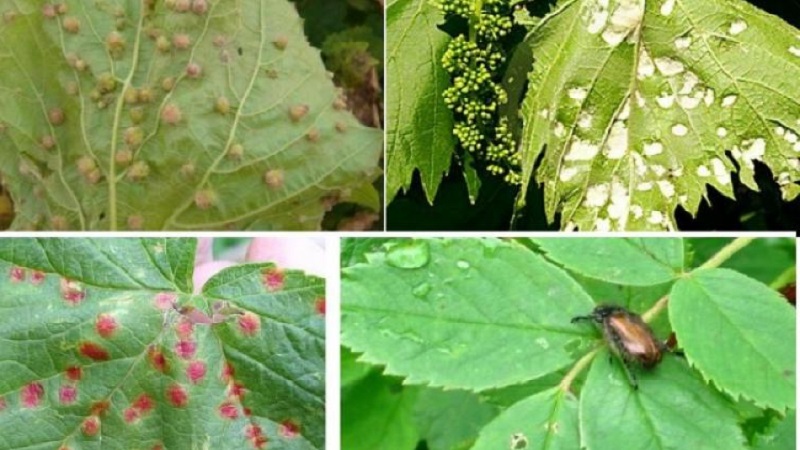
Rapture is immune to most grape diseases. Pests also rarely hit it. Despite this, it is important to follow the care rules:
- Site cleaning... During the summer, the soil around the bushes is regularly cleared of weeds - sources of diseases and pests. It is important to clean the area in autumn.
- Pruning. Sanitary pruning is carried out in autumn. The grapes are shaped so that their branches are not too close to the ground and the leaves do not create shading.
- Preventive treatments. In the spring, before flowering, the plant is sprayed with a solution of copper sulfate. The treatment is repeated after heavy rains. Once a month, grapes are watered with a light pink solution of potassium permanganate. Processing is carried out after prolonged rains.
- Landing. You can not thicken the planting.The distance between the plants is 4-6 m. Before planting, the planting material, garden tools and soil must be disinfected.
Harvesting and storage
In cold regions, Delight ripens in August, and in warm regions already in mid-June. It is not necessary to pick the fruit immediately after it ripens. They are able to hang on the bush and not deteriorate for up to 2 months.
The crop is harvested in dry, sunny weather. Store in a cool place directly on the bunches.
Growing tips from gardeners
Most gardeners believe that Rapture grapes live up to their name. Some of them know a few secrets of him successful cultivation.
Igor, Zheleznogorsk: “I live in the suburbs, I have been growing Delight for 10 years. Tried many other modern varieties, but this is my favorite. Handles our cold winters easily. I noticed that if there is no snow, the vines can freeze slightly. To prevent this from happening, I cover them with foil and branches. I use only natural fertilizing - ash and mullein. I bury it right under the bush. I really like the berries, which are great for wine. "
Irina, Sochi: “Delight has been growing on our site since my childhood. Very easy to care for grapes. All that is required of a gardener is to water, feed and shape him on time. And if you forget about it for a couple of weeks, then nothing bad will happen. I grow grapes for food, so I leave only 5 eyes - so the berries are large. "
Victor, Kursk: “I like Rapture Red. It has beautiful pink berries and a sweet-sour refreshing taste. It is unpretentious in leaving. It is important to plant it in a sunny part of the garden, as in the shade the fruits are sour. "
Conclusion
Delight is an old grape variety that still hasn't lost its relevance. On its basis, many hybrids have been bred. They are united by high frost resistance, tasty, large fruits, resistance to most diseases.
Taking care of grapes is easy. Timely watering, dressing and formation will be enough for the plant to please with high yield.